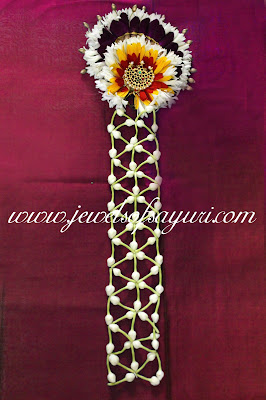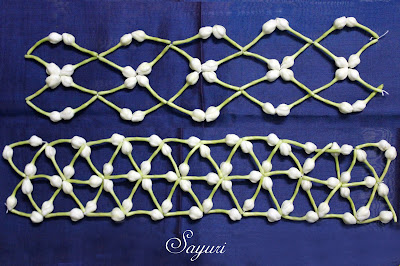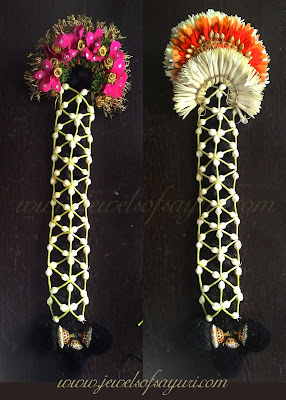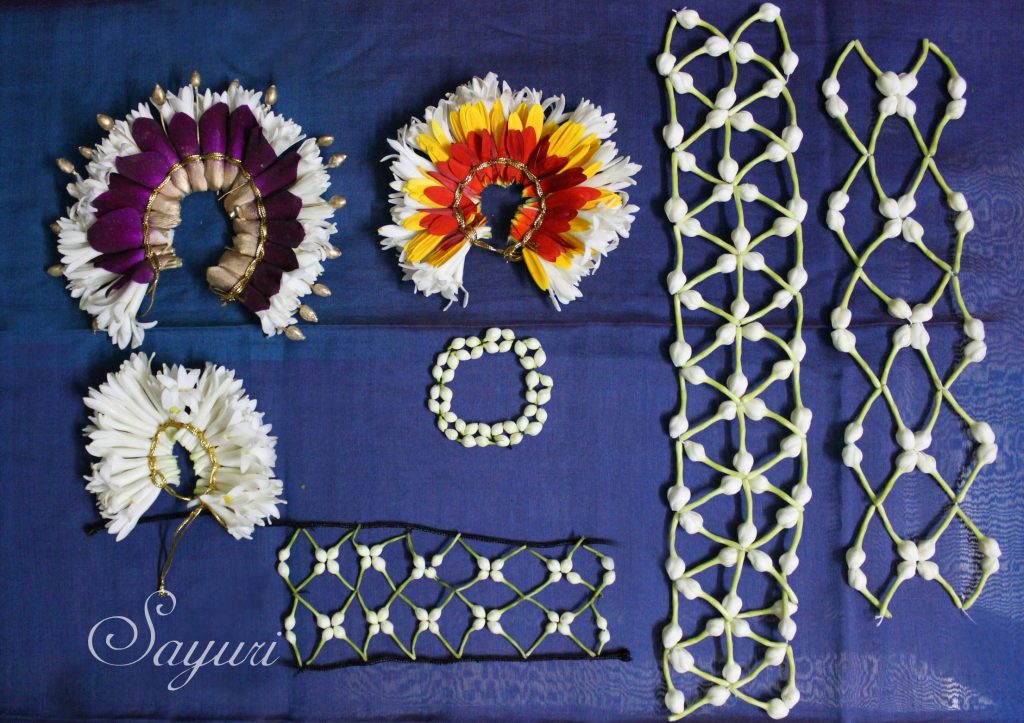Here is the continuation to my last post detailing my experiences at a floral hair accessories workshop. After successfully trying out Venis, I graduated to making floral nets and Floral Hair braids. Before I proceed to what I made, I want to offer a little background (filled with culture nuggets) on wearing flowers on the hair.
Floral Nets & Braids – A background
There is evidence of elaborate floral Nets and Braids being worn by women in India even in the Satavahana period (around 200 BC). In the beginning it was mostly worn by tribals, dancers and was slowly adapted by upper class women. It was considered as a part of Shola- Shringar (16 things that makes a woman beautiful and desirable). It was worn by pre-puberty girls in India even on an everyday basis (though more elaborate braids were reserved for festivals, celebrations and weddings) until the last 30 years. I remember my grandmother telling me how they would make hair embellishments using Thalampoo (Screw pine flower). It gradually diminished due to lack of time and exposure of western fashion of 70’s and 80’s. You cant wear flowers with tights, short skirts or jeans right?

The Practice of wearing flowers on the hair
In the North, wearing flowers became an outdated practice by the late 70’s. Gajras (Strand of flowers – mostly jasmine) were reserved for Deities or were worn during weddings or festivals. My mom recollects memories from her stay in Delhi in 1970’s, when she was told be her sister not to wear mixed or colored flowers in her hair while going out, as she might not be considered as a woman with high moral standards.
It’s a south(ern) story
But the south was and is a different story altogether – neatly combed hair with flowers on was considered as must, particularly in the evenings and people would not stop complaining until you put flowers on your head. It seems my grandfather (Father’s father) used to say that ‘only Widows and motherless children went by without wearing flowers, bindhi and jewellery’ and buy flowers by the heap to be strung by my grandmother for their daughters everyday.
Women, in the south, wore flower strands on their heads up until the last 10 years on an everyday basis. Now its almost gone, save the dramatic mentions of ” Poovum pottum” (flowers and bindhi) as the hallmark of a cultured woman (married) in Tamil TV serials.
A few years back, I remember reading about Aung San Suu Kyi’s India visit when she noted how “Indian women preferred not to wear flowers on their hair anymore”.
I remember my aunts (my father’s sisters) telling me, how they would match their flowers with their sarees and half sarees while going to school and college. They would wear kanakambaram (Crossandra infundibuliformis) with yellow, orange or red clothes, kadambam (mix of different flowers) with dark colors, December violet (Bluebell barleria) with pink outfits, December yellow and white (Barlerias) with pastel shades and varieties of jasmine like malli, mullai or Jaadi with with pretty much anything. Roses were a special treat and would often be used to entice children/teenagers to wear flowers. My mom used to be more stylish as she would wear either single roses (buds) in her hair or only freshly strung Jaadi jasmine.
My choice of flowers
Though I would try wearing each of the flowers once for novelty, my preference during school were either Mullai (jasmine) or roses. I had rose plants which I would carefully tend to and I particularly remember the months of June and December in 2002 when I used to wear a pink button rose in my long plaited black hair every evening, regardless of the kind of clothes I wore. Now I hardly wear flowers as my ever thinning hair is unable to support the weight of flower strands. I had to search really hard to find a picture of me with flowers and found one from 2010, below.
 Left: Moi with a jasmine strand and small rakodi 2010; Right: Moi with flower netting 2016
Left: Moi with a jasmine strand and small rakodi 2010; Right: Moi with flower netting 2016
Floral Nets & Braids workshop
 |
| Nets with bigger hybrid buds |
This is how the nets are supposed to be worn – stitched to the braids and decorated with venis at the top. Bhuvana our Instructor, taught us how to wrap it on an artificial hair braid as seen below. Floral nets can also be used to create jewellery as shown in the Bhahubali video here.
Coming back to the plait, the tassels that you see at the end are called Kunjam or kujalam (in the south) and are black velvet balls with ornamented bead caps.They not only make the braids look fancy but also add weight which helps in keep the plait long and straight. You also get parandha (Famous in Punjab) that are long colored tassels made of tinsel (ish) paper or soft yarn.

So that was the end of the workshop and here is all what I made in Half a day. I was pretty happy with the end result but I know I have to really practice a lot if I have to make these to sell. Do I have the patience for it, only time will tell.

Floral Nets & Braids – Making a comeback
I wore the bigger flower net to college the next day (see pic above) and roamed around the entire campus as I wanted the next generation students to see it, get curious and ask questions and hopefully in the process learn a little bit about India’s cultural heritage. It got a little kinked up by the end of the day but I enjoyed I all the attention I got wearing it. Indian culture, I believe, has survived for so long as we keep constantly reinventing it. So hopefully this new trend of floral nets and braids will keep the tradition of wearing flowers alive for a little longer
Then there is one more good news – WedMe Good one of the biggest Indian wedding sites have asked Sayuri to be their featured vendor for a month. I still cant believe that the industry thinks that I am a “Bridal Jewellery designer” 🙂 🙂 Do check out Sayuri’s profile at the website and rate us.
I hope you found it interesting
Cheers




Leave a Reply